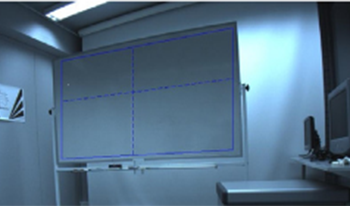
Whiteboards are commonly used as a medium of instant illustration of ideas during several activities including presentations, lectures, meetings, and related others through videoconferencing systems. However, the acquisition of whiteboard contents is inhibited by issues inherent to the camera technologies, the whiteboard glossy surfaces along with other environmental issues such as room lighting or camera positioning. The contents of whiteboards are mostly invisible due to the low luminance contrast and other related color degradation problems. This article presents an account of a work aimed at extracting the whiteboard image and consequently enhancing its perceptual quality and legibility. Two different methods based on color balancing and color warping are introduced to improve the global and local luminance contrast as well as color saturation of the contents. The methods are implemented based on different general models of the videoconferencing environment for avoiding color shifts and unnaturalness of results. Our evaluations, through psycho-visual experiments, reveal the significance of the proposed method's improvements over the state of the art methods in terms of visual quality and visibility. © 2018 Society for Imaging Science and Technology. [DOI: 10.2352/J.Percept.Imaging.2018.1.1.010504]

NASA's Soil Moisture Active Passive (SMAP) satellite mission combines a passive L-band radiometer and an active Synthetic Aperture Radar (SAR) instrument in order to monitor the near-surface soil moisture and freeze-thaw states globally, with a revisit frequency of 2-3 days. SMAP provides three soil moisture products: a high-resolution from the radar, a low-resolution from the radiometer, and an intermediate-resolution from the fusion of the radar and radiometer measurements. Unfortunately, SMAP's SAR instrument halted its transmissions after a short operating period. In order to address this limitation, we introduce a novel post-acquisition computational technique aiming to synthesize the active measurements of SMAP, by exploiting the mathematical frameworks of Sparse Representations and Dictionary Learning. We propose a coupled dictionary learning model which considers joint feature spaces, composed of active and passive images, in order to recover the missing active measurements. We formulate our coupled dictionary learning problem within the context of the Alternating Direction Method of Multipliers. Our experimental results demonstrate the ability of the proposed approach to reconstruct the active measurements, achieving better performance compared to state-of-the-art coupled dictionary learning techniques.

In color imaging, the two-dimension discrete Fourier transform (2-D DFT) is used to process separately color channels and in the quaternion space the processing of the image with 2-D quaternion Fourier transforms do consider interactions between the color channels. The color image can be also considered in different models with transformation to the octonion space with following processing in the 8-D frequency domain. In this work, we describe the algorithm for the 2-D two-side octonion DFT (ODFT), by using two-side 2-D quaternion DFTs.

The goal in photography is generally the construction of a model of scene appearance. Unfortunately, statistical variations introduced by photon shot and other noise introduce errors in the raw value reported for each pixel sample. Rather than simply accepting those values as the best raw representation, the current work treats them as initial estimates of the correct values, and computes an error model for each pixel's value. The value error models for all pixels in an image are then used to drive a type of texture synthesis which refines the pixel value estimates, potentially increasing both accuracy and precision of each value. Each refined raw pixel value is synthesized from the value estimates of a plurality of pixels with overlapping error bounds and similar context within the same image. The error modeling and texture synthesis algorithms are implemented in and evaluated using KREMY (KentuckY Raw Error Modeler, pronounced "creamy"), a free software tool created for this purpose.

New models of gray-scale image representation in the 4-D quaternion space are described, wherein images can be processed as quaternion and color images in the frequency domain, by using the concepts of the 2-D quaternion unitary transforms, such as quaternion discrete Fourier transforms, wavelet, and others. Methods of alpha-rooting by such 2-D transforms can be effectively used for gray-scale image enhancement, and optimal parameters enhancements can be found by using the measures EME and EMEC, and image visibility measures of image enhancement. Different models of transferring the gray-scale images into the quaternion space can be applied, which include models 2 × 2, 4 × 1, 4 × 1, and others.

Different kinds of noises have considerable effects on most of image sensing systems. Suitable image contrast enhancement algorithms can improve contrast or retain detail information while reducing noises as well. Fuzzy representation of an image provides a reliable analysis when inexactness occurred at the gray level values. This paper presents a fuzzy-based novel image contrast enhancement method. Several image quality indices, such as similarity, naturalness, and mean brightness preserving examined and experimentally show the effectiveness of the proposed technique in comparison with well-known image enhancement methods such as histogram equalization and contrast limited adaptive histogram equalization methods.